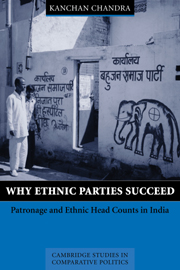Book contents
- Frontmatter
- Dedication
- Contents
- List of Maps, Figures, and Tables
- List of Abbreviations
- A Note on Terminology
- Acknowledgments
- 1 Introduction
- Part I Theory
- Part II Data
- Appendix A Elite Interviews
- Appendix B Ethnographies of Election Campaigns
- Appendix C Content Analysis
- Appendix D Description of Survey Data
- Appendix E Description of the Ecological Inference (EI) Method
- Appendix F Method Used to Estimate Ethnic Voting Patterns
- Bibliography
- Index
- Miscellaneous Endmatter
Appendix E - Description of the Ecological Inference (EI) Method
Published online by Cambridge University Press: 19 October 2017
- Frontmatter
- Dedication
- Contents
- List of Maps, Figures, and Tables
- List of Abbreviations
- A Note on Terminology
- Acknowledgments
- 1 Introduction
- Part I Theory
- Part II Data
- Appendix A Elite Interviews
- Appendix B Ethnographies of Election Campaigns
- Appendix C Content Analysis
- Appendix D Description of Survey Data
- Appendix E Description of the Ecological Inference (EI) Method
- Appendix F Method Used to Estimate Ethnic Voting Patterns
- Bibliography
- Index
- Miscellaneous Endmatter
Summary
The purpose of this appendix is to provide the reader with sufficient information on the ecological inference (EI) method to evaluate the method with which I arrive at the estimates of Scheduled Caste support for the BSP (section I), to evaluate the use of these estimates for the second-stage analysis of strategic voting (Section II), and to underline the possibilities for research on ethnic politics created by EI (section III). It would be most useful for the reader if read in combination with King's A Solution to the Ecological Inference Problem (Princeton: Princeton University Press, 1997).
Use of EI to Generate Constituency-Level Estimates of Scheduled Caste Voting Behaviour
The ecological inference problem that I address here is how to estimate the proportion of Scheduled Castes who voted for the BSP in each constituency. King's method solves this problem in two iterations. In the first iteration, it is used to estimate the proportion of Scheduled Castes who turned out in each constituency. The logic of the method is as follows. For any constituency, we can compute deterministic bounds on turnout rates for Scheduled Castes and non–Scheduled Castes in the population. Once we have these deterministic bounds for each constituency, EI computes a probabilistic model showing where the turnout rates are likely to lie by “borrowing strength” from all constituencies in order to produce estimates for each. Using King's notation, the ecological inference problem at iteration 1 is as follows:
Xi = Proportion of SCs in the electorate in constituency i
1 − Xi = Proportion of non-SCs in the electorate in constituency i
Ti = Proportion of electors who turn out to vote in constituency i
1 − Ti = Proportion of electors who do not turn out in constituency i
βib = Proportion of Scheduled Castes who turn out in constituency i
1 − βib = Proportion of Scheduled Castes who do not turn out in constituency i
βiw = Proportion of non–Scheduled Castes who turn out in constituency i
1 − βiw = Proportion of non–Scheduled Castes who do not turn out in constituency i
- Type
- Chapter
- Information
- Why Ethnic Parties SucceedPatronage and Ethnic Head Counts in India, pp. 303 - 309Publisher: Cambridge University PressPrint publication year: 2004



